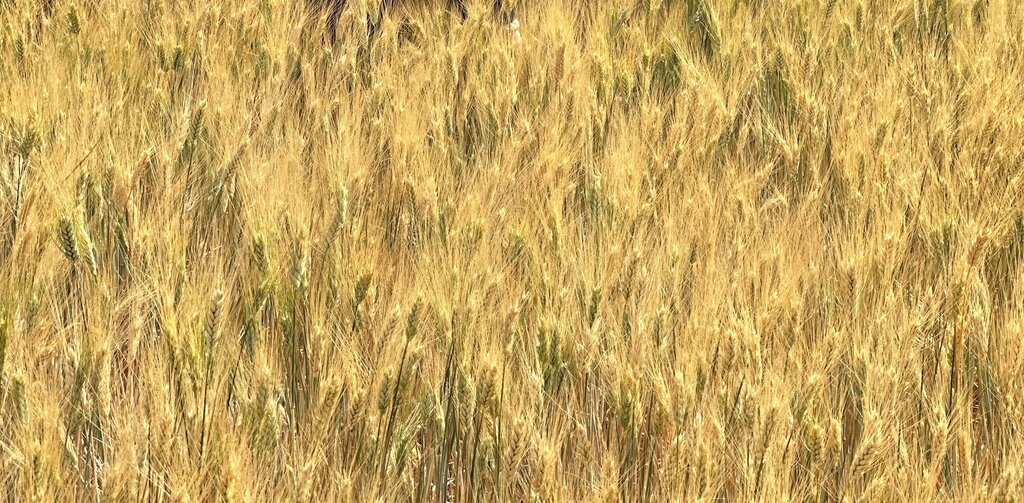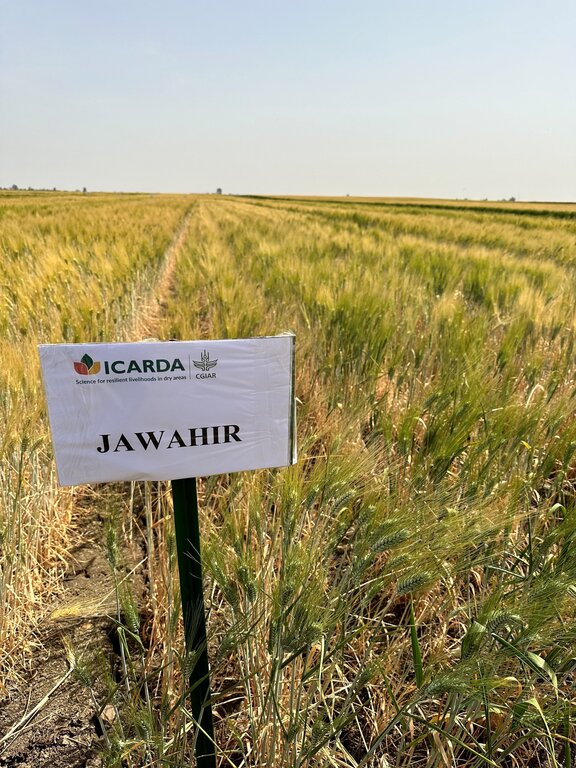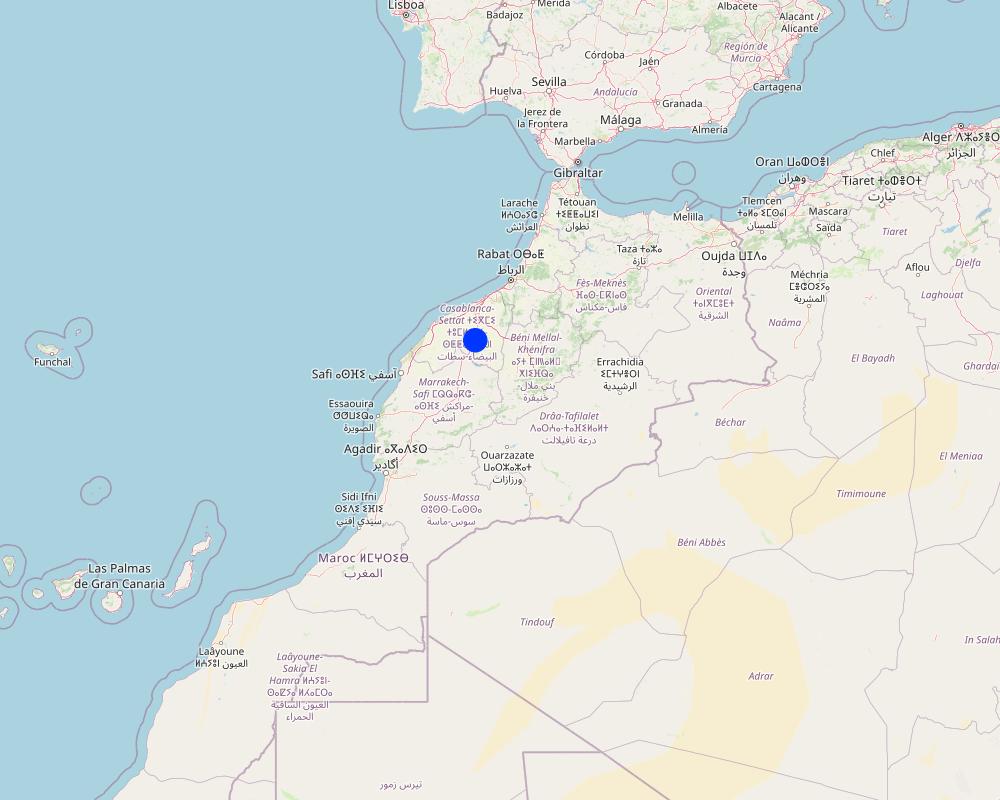Drought tolerant durum wheat variety: Jawahir [โมร็อกโก]
- ผู้สร้างสรรค์:
- การอัพเดท:
- ผู้รวบรวม: Joren Verbist
- ผู้เรียบเรียง: –
- ผู้ตรวจสอบ: William Critchley, Rima Mekdaschi Studer
technologies_6804 - โมร็อกโก
ดูส่วนย่อย
ขยายทั้งหมด ย่อทั้งหมด1. ข้อมูลทั่วไป
1.2 รายละเอียดที่ติดต่อได้ของผู้รวบรวมและองค์กรที่เกี่ยวข้องในการประเมินและการจัดเตรียมทำเอกสารของเทคโนโลยี
วิทยากรหลัก
Principal Investigator Genetic Innovation:
Bassi Filippo
International Center of Agriculture Research in the Dry Areas (ICARDA)
โมร็อกโก
Research Assistant, Entomology:
Boulamtat Rachid
International Center of Agriculture Research in the Dry Areas (ICARDA)
โมร็อกโก
Breeding Lead:
Ferrahi Moha
Institut National de la Recherche Agronomique (INRA)
โมร็อกโก
ชื่อของโครงการซึ่งอำนวยความสะดวกในการทำเอกสารหรือการประเมินเทคโนโลยี (ถ้าเกี่ยวข้อง)
ICARDA Institutional Knowledge Management Initiativeชื่อขององค์กรซึ่งอำนวยความสะดวกในการทำเอกสารหรือการประเมินเทคโนโลยี (ถ้าเกี่ยวข้อง)
ICARDA International Center for Agricultural Research in the Dry Areas (ICARDA) - ซีเรีย1.3 เงื่อนไขการใช้ข้อมูลที่ได้บันทึกผ่านทาง WOCAT
ผู้รวบรวมและวิทยากรหลักยอมรับเงื่อนไขเกี่ยวกับการใช้ข้อมูลที่ถูกบันทึกผ่านทาง WOCAT:
ใช่
1.4 การเปิดเผยเรื่องความยั่งยืนของเทคโนโลยีที่ได้อธิบายไว้
เทคโนโลยีที่ได้อธิบายไว้นี้เป็นปัญหาของความเสื่อมโทรมโทรมของที่ดินหรือไม่ จึงไม่ได้รับการยอมรับว่าเป็นเทคโนโลยีเพื่อการจัดการที่ดินอย่างยั่งยืน:
ไม่ใช่
2. การอธิบายลักษณะของเทคโนโลยี SLM
2.1 การอธิบายแบบสั้น ๆ ของเทคโนโลยี
คำจำกัดความของเทคโนโลยี:
Jawahir, an improved durum wheat variety, serves as a resilient solution to the challenges of climate change in dry areas by offering disease and pest resistance, drought tolerance, higher grain and straw yields, as well as cost savings, thereby enhancing farmers' income and sustainability.
2.2 การอธิบายแบบละเอียดของเทคโนโลยี
คำอธิบาย:
Climate change exacerbates the difficulties faced by farmers in dry areas by amplifying drought conditions. Limited water availability and higher temperatures disrupt crop growth and heighten the vulnerability of plants to pests such as the Hessian fly (Mayetiola destructor). This leads to increased risks of crop damage, reduced yields, and economic losses in these regions.
Genetically improving crop varieties can help overcome these issues by making crops more resilient. An international collaboration led by the International Center of Agricultural Research in Dry Areas (ICARDA-Morocco) has delivered six ground-breaking new durum wheat and barley varieties tolerant to increasingly severe droughts ravaging the region. Improvement is performed through Molecular Breeding which consists of markers to select specific traits and conventional phenotypic.
This case study revolves around an improved durum wheat variety named Jawahir. The main advantages of this variety are:
•Cost savings: Jawahir's suitability for zero tillage helps to eliminate the need for ploughing, reducing the associated costs for farmers.
•Disease and pest resistance: Jawahir's resistance to diseases and pests, including the Hessian fly, minimizes the expenses related to fungicides and insecticides.
•Higher grain yield: Compared to competing varieties (like Karim and Kanakis), Jawahir can yield an additional 700 kilograms per hectare under dry conditions, increasing farmers' productivity and potential income.
•Enhanced straw yield: Jawahir also produces an additional 500 kilograms of straw compared to competing varieties during drought, providing additional feed for fodder and for mulching under conservation agriculture systems.
Jawahir was introduced in the Settat-Safi region (Morocco) where annual precipitation is between 300 and 400 mm. While cultivation practices may vary, it is recommended to include Jawahir in a conservation agriculture (zero/ minimum till) system. Crop management includes machine seeding in November at a rate of 200 kg per hectare corresponding to approximately 300 plants per square meter. Fertilizer application consists of manually applying 200 kg of NPK (15:20:15) in November and 100 kg of urea in February. Herbicide application of 1 litre is suggested in February. Harvesting takes place in June using a combine harvester, and during July and August, the stubble is left for grazing. Following this crop management system, the costs per hectare are estimated to be around 2610 Moroccan Dirham (about 261 USD) per hectare.
The direct gross income from Jawahir, based on grain yield, is approximately 1,120 USD per hectare, based on a yield of 3,200 kilograms and a selling price of 35 USD per 100 kilograms. The additional gross income from straw yield is around 1,100 USD per hectare, assuming a yield of 5,500 kilograms and a price of 20 USD per 100 kilograms. This results in a total direct gross income of 2,220 USD per hectare.
However, if processed into couscous for human consumption, Jawahir's higher semolina yield (i.e. more kilograms of semolina per kilogram of grain milled) and better semolina color means an extra gross income of 4,560 USD per hectare. Additionally, when the straw is used for animal fattening, the extra output per hectare is around 900 kilograms of lamb meat (based on a conversion rate of 6 kilograms of feed to 1 kilogram of meat). Then the total extra gross income from production of meat is 5,500 USD per hectare.
Including both direct and indirect income, Jawahir provides a total gross income of approximately 12,280 USD per hectare from grain, straw, couscous, and animal fattening.
In conclusion, enhanced crop varieties like Jawahir offer increased resilience to the challenges posed by climate change in dry areas. These varieties provide benefits such as cost savings, disease and pest resistance, and improved yields. By adopting these varieties, farmers can enhance their agricultural productivity and mitigate the impacts of climate change on their livelihoods.
Acknowledgement: ICARDA’s work on breeding is supported by the Accelerated Breeding Initiative of the CGIAR and The Crop Trust. The variety release was through INRA Morocco.
2.3 รูปภาพของเทคโนโลยี
2.5 ประเทศภูมิภาค หรือสถานที่ตั้งที่เทคโนโลยีได้นำไปใช้และได้รับการครอบคลุมโดยการประเมินนี้
ประเทศ:
โมร็อกโก
ภูมิภาค/รัฐ/จังหวัด:
Settat-Safi
ระบุการกระจายตัวของเทคโนโลยี:
- กระจายไปอย่างสม่ำเสมอในพื้นที่
If precise area is not known, indicate approximate area covered:
- 0.1-1 ตร.กม.
Is/are the technology site(s) located in a permanently protected area?
ไม่ใช่
Map
×2.6 วันที่การดำเนินการ
ระบุปีที่ใช้:
2022
2.7 คำแนะนำของเทคโนโลยี
ให้ระบุว่าเทคโนโลยีถูกแนะนำเข้ามาอย่างไร:
- ในช่วงการทดลองหรือการทำวิจัย
- ทางโครงการหรือจากภายนอก
3. การจัดประเภทของเทคโนโลยี SLM
3.1 วัตถุประสงค์หลักของเทคโนโลยี
- ปรับปรุงการผลิตให้ดีขึ้น
- ลดความเสี่ยงของภัยพิบัติ
- ปรับตัวเข้ากับการเปลี่ยนแปลงภูมิอากาศของโลก สภาพภูมิอากาศที่รุนแรงและผลกระทบ
- สร้างผลกระทบทางด้านเศรษฐกิจที่เป็นประโยชน์
- สร้างผลกระทบทางด้านสังคมที่เป็นประโยชน์
3.2 ประเภทของการใช้ที่ดินในปัจจุบันที่ได้นำเทคโนโลยีไปใช้
Land use mixed within the same land unit:
ไม่ใช่

พื้นที่ปลูกพืช
- การปลูกพืชล้มลุกอายุปีเดียว
- Durum what: Jawahir
จำนวนของฤดูเพาะปลูกต่อปี:
- 2
Is intercropping practiced?
ไม่ใช่
Is crop rotation practiced?
ใช่
ถ้าใช่ ระบุ:
Jawahir can be included in crop rotations, especially well fitted with Conservation Agriculture. This could include legumes (e.g., vetch or faba bean) as well.
3.3 Has land use changed due to the implementation of the Technology?
Has land use changed due to the implementation of the Technology?
- No (Continue with question 3.4)
3.4 การใช้น้ำ
การใช้น้ำของที่ดินที่มีการใช้เทคโนโลยีอยู่:
- จากน้ำฝน
3.5 กลุ่ม SLM ที่ตรงกับเทคโนโลยีนี้
- การปรับปรุงพันธุ์พืชหรือพันธุ์สัตว์ต่าง ๆ
3.6 มาตรการ SLM ที่ประกอบกันเป็นเทคโนโลยี

มาตรการจัดการพืช
- A5: การจัดการเมล็ดพันธุ์ การปรับปรุงพันธุ์
3.7 รูปแบบหลักของการเสื่อมโทรมของที่ดินที่ได้รับการแก้ไขโดยเทคโนโลยี

การเสื่อมโทรมของดินทางด้านเคมี
- Cn (Fertility decline): ความอุดมสมบูรณ์และปริมาณอินทรียวัตถุในดินถูกทำให้ลดลงไป (ไม่ได้เกิดจากสาเหตุการกัดกร่อน)

การเสื่อมโทรมของดินทางด้านชีวภาพ
- Bp (Increase of pests/diseases): การเพิ่มขึ้นของศัตรูพืชและโรคพืช
3.8 การป้องกัน การลดลง หรือการฟื้นฟูความเสื่อมโทรมของที่ดิน
ระบุเป้าหมายของเทคโนโลยีกับความเสื่อมโทรมของที่ดิน:
- ลดความเสื่อมโทรมของดิน
- ปรับตัวกับสภาพความเสื่อมโทรมของที่ดิน
4. ข้อมูลจำเพาะด้านเทคนิค กิจกรรมการนำไปปฏิบัติใช้ ปัจจัยนำเข้า และค่าใช้จ่าย
4.1 แบบแปลนทางเทคนิคของเทคโนโลยี
ข้อมูลจำเพาะด้านเทคนิค (แบบแปลนทางเทคนิคของเทคโนโลยี):
The recommended plant density is around 300 plants per square meter.
4.2 ข้อมูลทั่วไปเกี่ยวกับการคำนวณปัจจัยนำเข้าและค่าใช้จ่าย
ให้ระบุว่าค่าใช้จ่ายและปัจจัยนำเข้าได้รับการคำนวณอย่างไร:
- ต่อพื้นที่ที่ใช้เทคโนโลยี
ระบุขนาดและหน่วยพื้นที่:
1 Hectare
อื่นๆ หรือสกุลเงินประจำชาติ (ระบุ):
Morrocan Dirham
If relevant, indicate exchange rate from USD to local currency (e.g. 1 USD = 79.9 Brazilian Real): 1 USD =:
10.0
ระบุค่าเฉลี่ยของค่าจ้างในการจ้างแรงงานต่อวัน:
80
4.5 การบำรุงรักษาสภาพหรือกิจกรรมที่เกิดขึ้นเป็นประจำ
| กิจกรรม | ช่วงระยะเวลา/ความถี่ | |
|---|---|---|
| 1. | Seeding | November |
| 2. | First fertilizer application (NPK) | November |
| 3. | Second fertilizer application (Urea) | Ferbruary |
| 4. | Herbicide application | February |
| 5. | Harvesting | June |
| 6. | Stubble left for grazing | June - August |
4.6 ค่าใช้จ่ายของปัจจัยนำเข้าและกิจกรรมที่เกิดขึ้นเป็นประจำที่ต้องการการบำรุงรักษา (ต่อปี)
| ปัจจัยนำเข้า | หน่วย | ปริมาณ | ค่าใช้จ่ายต่อหน่วย | ค่าใช้จ่ายทั้งหมดต่อปัจจัยนำเข้า | %ของค่าใช้จ่ายที่ก่อให้เกิดขึ้นโดยผู้ใช้ที่ดิน | |
|---|---|---|---|---|---|---|
| แรงงาน | Seeding | Person-day | 2.0 | 80.0 | 160.0 | |
| แรงงาน | Fertilizer application | Person-day | 4.0 | 80.0 | 320.0 | |
| แรงงาน | Herbicide application | Person-day | 2.0 | 80.0 | 160.0 | |
| แรงงาน | Harvesting | Person-day | 2.0 | 80.0 | 160.0 | |
| อุปกรณ์ | Seeder | Machine-hour | 2.0 | 100.0 | 200.0 | |
| อุปกรณ์ | Combine | Machine-hour | 2.0 | 200.0 | 400.0 | |
| วัสดุด้านพืช | Jawahir seed | 100 Kilogram | 2.0 | 130.0 | 260.0 | |
| ปุ๋ยและสารฆ่า/ยับยั้งการเจริญเติบโตของสิ่งมีชีวิต (ไบโอไซด์) | First fertilizer: NPK (15:20:15) | 100 Kilogram | 2.0 | 250.0 | 500.0 | |
| ปุ๋ยและสารฆ่า/ยับยั้งการเจริญเติบโตของสิ่งมีชีวิต (ไบโอไซด์) | Second fertilizer: Urea | 100 Kilogram | 1.0 | 200.0 | 200.0 | |
| ปุ๋ยและสารฆ่า/ยับยั้งการเจริญเติบโตของสิ่งมีชีวิต (ไบโอไซด์) | Herbicide | Liter | 1.0 | 250.0 | 250.0 | |
| ค่าใช้จ่ายทั้งหมดของการบำรุงรักษาสภาพเทคโนโลยี | 2610.0 | |||||
| Total costs for maintenance of the Technology in USD | 261.0 | |||||
5. สิ่งแวดล้อมทางธรรมชาติและของมนุษย์
5.1 ภูมิอากาศ
ฝนประจำปี
- < 250 ม.ม.
- 251-500 ม.ม.
- 501-750 ม.ม.
- 751-1,000 ม.ม.
- 1,001-1,500 ม.ม.
- 1,501-2,000 ม.ม.
- 2,001-3,000 ม.ม.
- 3,001-4,000 ม.ม.
- > 4,000 ม.ม.
เขตภูมิอากาศเกษตร
- กึ่งแห้งแล้ง
- แห้งแล้ง
5.2 สภาพภูมิประเทศ
ค่าเฉลี่ยความลาดชัน:
- ราบเรียบ (0-2%)
- ลาดที่ไม่ชัน (3-5%)
- ปานกลาง (6-10%)
- เป็นลูกคลื่น (11-15%)
- เป็นเนิน (16-30%)
- ชัน (31-60%)
- ชันมาก (>60%)
ธรณีสัณฐาน:
- ที่ราบสูง/ที่ราบ
- สันเขา
- ไหล่เขา
- ไหล่เนินเขา
- ตีนเนิน
- หุบเขา
ระดับความสูง:
- 0-100 เมตร
- 101-500 เมตร
- 501-1,000 เมตร
- 1,001-1,500 เมตร
- 1,501-2,000 เมตร
- 2,001-2,500 เมตร
- 2,501-3,000 เมตร
- 3,001-4,000 เมตร
- > 4,000 เมตร
ให้ระบุถ้าเทคโนโลยีได้ถูกนำไปใช้:
- ไม่เกี่ยวข้อง
5.3 ดิน
ค่าเฉลี่ยความลึกของดิน:
- ตื้นมาก (0-20 ซ.ม.)
- ตื้น (21-50 ซ.ม.)
- ลึกปานกลาง (51-80 ซ.ม.)
- ลึก (81-120 ซ.ม.)
- ลึกมาก (>120 ซ.ม.)
เนื้อดิน (ดินชั้นบน):
- ปานกลาง (ดินร่วน ทรายแป้ง)
เนื้อดินล่าง (> 20 ซ.ม.ต่ำจากผิวดิน):
- ปานกลาง (ดินร่วน ทรายแป้ง)
อินทรียวัตถุในดิน:
- ต่ำ (<1%)
5.4 ความเป็นประโยชน์และคุณภาพของน้ำ
ระดับน้ำใต้ดิน:
5-50 เมตร
น้ำไหลบ่าที่ผิวดิน:
ไม่ดีหรือไม่มีเลย
คุณภาพน้ำ (ที่ยังไม่ได้บำบัด):
เป็นน้ำเพื่อการดื่มที่ไม่ดี (จำเป็นต้องได้รับการบำบัด)
Water quality refers to:
ground water
ความเค็มของน้ำเป็นปัญหาหรือไม่:
ใช่
กำลังเกิดน้ำท่วมในพื้นที่หรือไม่:
ไม่ใช่
5.5 ความหลากหลายทางชีวภาพ
ความหลากหลายทางชนิดพันธุ์:
- ต่ำ
ความหลากหลายของแหล่งที่อยู่:
- ต่ำ
5.6 ลักษณะของผู้ใช้ที่ดินที่นำเทคโนโลยีไปปฏิบัติใช้
อยู่กับที่หรือเร่ร่อน:
- อยู่กับที่
แนวทางการตลาดของระบบการผลิต:
- mixed (subsistence/ commercial)
รายได้ที่มาจากนอกฟาร์ม:
- < 10% ของรายได้ทั้งหมด
ระดับของความมั่งคั่งโดยเปรียบเทียบ:
- จน
เป็นรายบุคคล/ครัวเรือน:
- เป็นรายบุคคล/ครัวเรือน
ระดับของการใช้เครื่องจักรกล:
- การใช้เครื่องจักรหรือเครื่องยนต์
เพศ:
- หญิง
- ชาย
อายุของผู้ใช้ที่ดิน:
- วัยกลางคน
5.7 Average area of land used by land users applying the Technology
- < 0.5 เฮกตาร์
- 0.5-1 เฮกตาร์
- 1-2 เฮกตาร์
- 2-5 เฮกตาร์
- 5-15 เฮกตาร์
- 15-50 เฮกตาร์
- 50-100 เฮกตาร์
- 100-500 เฮกตาร์
- 500-1,000 เฮกตาร์
- 1,000-10,000 เฮกตาร์
- >10,000 เฮกตาร์
พิจารณาว่าเป็นขนาดเล็ก กลาง หรือขนาดใหญ่ (ซึ่งอ้างอิงถึงบริบทระดับท้องถิ่น):
- ขนาดเล็ก
- ขนาดกลาง
5.8 กรรมสิทธิ์ในที่ดิน สิทธิในการใช้ที่ดินและสิทธิในการใช้น้ำ
กรรมสิทธิ์ในที่ดิน:
- รายบุคคล ไม่ได้รับสิทธิครอบครอง
- รายบุคคล ได้รับสิทธิครอบครอง
สิทธิในการใช้ที่ดิน:
- รายบุคคล
สิทธิในการใช้น้ำ:
- รายบุคคล
Are land use rights based on a traditional legal system?
ใช่
5.9 การเข้าถึงบริการและโครงสร้างพื้นฐาน
สุขภาพ:
- จน
- ปานกลาง
- ดี
การศึกษา:
- จน
- ปานกลาง
- ดี
ความช่วยเหลือทางด้านเทคนิค:
- จน
- ปานกลาง
- ดี
การจ้างงาน (เช่น ภายนอกฟาร์ม):
- จน
- ปานกลาง
- ดี
ตลาด:
- จน
- ปานกลาง
- ดี
พลังงาน:
- จน
- ปานกลาง
- ดี
ถนนและการขนส่ง:
- จน
- ปานกลาง
- ดี
น้ำดื่มและการสุขาภิบาล:
- จน
- ปานกลาง
- ดี
บริการด้านการเงิน:
- จน
- ปานกลาง
- ดี
6. ผลกระทบและสรุปคำบอกกล่าว
6.1 ผลกระทบในพื้นที่ดำเนินการ (On-site) จากการใช้เทคโนโลยี
ผลกระทบทางด้านเศรษฐกิจและสังคม
การผลิต
การผลิตพืชผล
การผลิตพืชที่ใช้เลี้ยงปศุสัตว์
การเสี่ยงต่อความล้มเหลวในการผลิต
รายได้และค่าใช้จ่าย
ค่าใช่จ่ายของปัจจัยการผลิตทางการเกษตร
แสดงความคิดเห็น/ระบุ:
When used in Conservation Agriculture
รายได้จากฟาร์ม
ภาระงาน
แสดงความคิดเห็น/ระบุ:
When used in Conservation Agriculture
ผลกระทบด้านสังคมวัฒนธรรมอื่น ๆ
ความมั่นคงด้านอาหาร / พึ่งตนเองได้
ผลกระทบด้านนิเวศวิทยา
ลดความเสี่ยงของภัยพิบัติ
ผลกระทบจากภัยแล้ง
Specify assessment of on-site impacts (measurements):
Data was retrieved from field trials and expert (also farmer) estimation.
6.2 ผลกระทบนอกพื้นที่ดำเนินการ (Off-site) จากการใช้เทคโนโลยี
Specify assessment of off-site impacts (measurements):
Not applicable/relevant
6.3 การเผชิญและความตอบสนองของเทคโนโลยีต่อการเปลี่ยนแปลงสภาพภูมิอากาศที่ค่อยเป็นค่อยไป และสภาพรุนแรงของภูมิอากาศ / ภัยพิบัติ (ที่รับรู้ได้โดยผู้ใช้ที่ดิน)
การเปลี่ยนแปลงสภาพภูมิอากาศที่ค่อยเป็นค่อยไป
การเปลี่ยนแปลงสภาพภูมิอากาศที่ค่อยเป็นค่อยไป
| ฤดู | increase or decrease | เทคโนโลยีมีวิธีการรับมืออย่างไร | |
|---|---|---|---|
| อุณหภูมิประจำปี | เพิ่มขึ้น | ดีมาก |
สภาพรุนแรงของภูมิอากาศ (ภัยพิบัติ)
ภัยพิบัติจากสภาพภูมิอากาศ
| เทคโนโลยีมีวิธีการรับมืออย่างไร | |
|---|---|
| คลื่นความร้อน | ดี |
| ภัยจากฝนแล้ง | ดี |
ภัยพิบัติทางชีวภาพ
| เทคโนโลยีมีวิธีการรับมืออย่างไร | |
|---|---|
| การบุกรุกของแมลง / หนอน | ดี |
แสดงความคิดเห็น:
Very well again Hesian fly
6.4 การวิเคราะห์ค่าใช้จ่ายและผลประโยชน์ที่ได้รับ
ผลประโยชน์ที่ได้รับเปรียบเทียบกับค่าใช้จ่ายในการจัดตั้งเป็นอย่างไร (จากมุมมองของผู้ใช้ที่ดิน)
ผลตอบแทนระยะสั้น:
ด้านบวกอย่างมาก
ผลตอบแทนระยะยาว:
ด้านบวกอย่างมาก
ผลประโยชน์ที่ได้รับเปรียบเทียบกับค่าใช้จ่ายในการบำรุงรักษาหรือต้นทุนที่เกิดขึ้นซ้ำอีก เป็นอย่างไร (จากมุมมองของผู้ใช้ที่ดิน)
ผลตอบแทนระยะสั้น:
ด้านบวกอย่างมาก
ผลตอบแทนระยะยาว:
ด้านบวกอย่างมาก
6.5 การปรับตัวของเทคโนโลยี
- 1-10%
ถ้ามีข้อมูลให้บอกปริมาณด้วย (จำนวนของครัวเรือนหรือครอบคลุมพื้นที่):
4 farms have adopted for seed production
Of all those who have adopted the Technology, how many did so spontaneously, i.e. without receiving any material incentives/ payments?
- 0-10%
แสดงความคิดเห็น:
Four farms do not receive subsidies, but do receive technical support.
6.6 การปรับตัว
เทคโนโลยีได้รับการปรับเปลี่ยนเมื่อเร็วๆนี้ เพื่อให้ปรับตัวเข้ากับสภาพที่กำลังเปลี่ยนแปลงหรือไม่:
ไม่ใช่
6.7 จุดแข็ง / ข้อได้เปรียบ / โอกาสของเทคโนโลยี
| จุดแข็ง / ข้อได้เปรียบ / โอกาสในทัศนคติของผู้ใช้ที่ดิน |
|---|
| Drought tolerant |
| Resistant to pests and diseases |
| Higher yield than other varieties |
| จุดแข็ง / ข้อได้เปรียบ / โอกาสในทัศนคติของผู้รวบรวมหรือวิทยากรหลัก |
|---|
| Although it is recommended to cultivate within Conservation Agriculture, it can be easily incorporated in conventional systems |
6.8 จุดอ่อน / ข้อเสียเปรียบ / ความเสี่ยงของเทคโนโลยีและวิธีการแก้ไข
| จุดอ่อน / ข้อเสียเปรียบ / ความเสี่ยงในทัศนคติของผู้ใช้ที่ดิน | มีวิธีการแก้ไขได้อย่างไร |
|---|---|
| Primary risk is the potential failure of seed production in the early stages. | To support the production process to the fullest extent possible. |
| จุดอ่อน / ข้อเสียเปรียบ / ความเสี่ยงในทัศนคติของผู้รวบรวมหรือวิทยากรหลัก | มีวิธีการแก้ไขได้อย่างไร |
|---|---|
| Primary risk is the potential failure of seed production in the early stages, which could prevent Jawahir from reaching its full market potential. | To support the production process to the fullest extent possible. |
7. การอ้างอิงและการเชื่อมต่อ
7.1 วิธีการและแหล่งข้อมูล
- ไปเยี่ยมชมภาคสนาม การสำรวจพื้นที่ภาคสนาม
- การสัมภาษณ์ผู้เชี่ยวชาญด้าน SLM หรือผู้ชำนาญ
- การเก็บรวบรวมมาจากรายงานและเอกสารที่มีอยู่
วันที่เก็บรวบรวมข้อมูล(ภาคสนาม) :
2022
7.3 Links to relevant online information
ชื่อเรื่องหรือคำอธิบาย:
Filippo Bassi, Hajar Brahmi, Abdelhadi Sabraoui, Ahmed Amri, Nasserlehaq Nsarellah, Nachit Miloudi, Ayed Al-Abdallat, Ming-Shun Chen, Abderrahim Lazraq, Mustapha El Bouhssini. (8/2/2019). Genetic identification of loci for Hessian fly resistance in durum wheat. Molecular Breeding, 39 (2).
URL:
https://hdl.handle.net/20.500.11766/10902
ชื่อเรื่องหรือคำอธิบาย:
Noureddine El Haddad, Miguel Sanchez-Garcia, Andrea Visioni, Jilal Abderrazek, Rola El Amil, Amadou T. Sall, Wasihun Lagesse, Shiv Kumar Agrawal, Filippo Bassi. (11/11/2021). Crop Wild Relatives Crosses: Multi-Location Assessment in Durum Wheat, Barley, and Lentil. Agronomy, 11 (11).
URL:
https://hdl.handle.net/20.500.11766/66379
ชื่อเรื่องหรือคำอธิบาย:
Noureddine El Haddad, Hafssa Kabbaj, Meryem Zaim, Khaoula El Hassouni, Amadou T. Sall, Mounira Azouz, Rodomiro Ortiz, Michael Baum, Ahmed Amri, Fernanda M. Gamba, Filippo Bassi. (1/2/2021). Crop wild relatives use in durum wheat breeding: drift or thrift. Crop Science, 61 (1), pp. 37-54.
URL:
https://hdl.handle.net/20.500.11766/11254
ลิงก์และโมดูล
ขยายทั้งหมด ย่อทั้งหมดลิงก์
ไม่มีลิงก์
โมดูล
ไม่มีโมดูล






